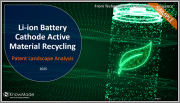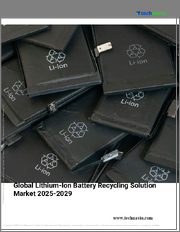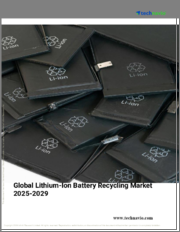
|
시장보고서
상품코드
1787845
세계의 리튬 이온 배터리 재활용 시장 : 공급원, 재활용 프로세스, 배터리 화학물질, 배터리 컴포넌트, 최종사용자 산업, 지역별(-2032년)Global Li-Ion Batteries Recycling Market Research Report by Source, by Recycling Process, by Battery Chemistry, by Battery Component, by End-Use Industry, by Region Forecast till 2032 |
||||||
세계 리튬 이온 배터리 재활용 시장 규모는 빠르게 확대되어 2023년 42억 1,710만 달러에서 2032년까지 연평균 20.1%를 보일 것으로 예측됩니다.
리튬 이온 배터리 재활용 시장은 전 세계적으로 전기자동차의 보급이 확대되면서 꾸준히 성장하고 있습니다. 전기차 운행 대수가 증가함에 따라 사용 후 배터리의 수가 증가함에 따라 신뢰할 수 있는 재활용 시스템의 필요성이 증가하고 있습니다. 폐배터리에서 회수되는 리튬, 코발트 등의 원료는 원자재 가격 상승이 지속되면서 그 가치가 점점 더 높아지고 있습니다.
큰 걸림돌 중 하나는 재활용에 필요한 장비와 인건비가 비싸다는 것입니다. 또한, 공급망 지연으로 인해 사용한 배터리를 신속하고 효율적으로 회수하여 처리 공정에 투입하는 데 어려움을 겪을 수 있습니다. 그럼에도 불구하고 새로운 기술의 도입으로 재활용 비용 절감과 효율성이 향상되고 있습니다. 기업과 정부 기관 간의 파트너십도 더 나은 시스템과 규제를 구축하기 위해 노력하고 있으며, 이러한 노력은 현실적인 운영 방식을 변화시키고 산업에 새로운 길을 열어줄 수 있는 잠재력을 가지고 있습니다. 또한, 지속적인 투자와 지원으로 배터리 재활용이 더욱 보편적인 관행이 되어 궁극적으로 폐기물을 줄이고 귀중한 자원을 보호할 수 있을 것으로 기대됩니다.
지역별 인사이트
북미 시장은 전기자동차 제조의 급격한 성장과 기업의 지속가능성에 대한 관심 증가로 인해 주도되고 있습니다. 미국과 캐나다에서는 공공 및 민간 부문이 주도적으로 이니셔티브를 추진하고 있으며, 새로운 재활용 기술에 대한 강력한 자금 투입과 함께 지역 전체의 발전을 촉진하고 있습니다. 자동차 산업과 기술 산업은 폐쇄형 루프 시스템을 통해 코발트, 리튬과 같은 귀중한 자원을 회수하기 위해 노력하고 있습니다.
유럽에서는 부족한 인프라를 세계에서 가장 선진적인 환경 정책으로 보완하여 탄탄한 재활용 체계를 구축할 수 있도록 하고 있습니다. EU 배터리 지침과 같은 정책이 국내 재활용 인프라에 대한 투자를 촉진했습니다. 현재 지역 내 여러 기업들이 대규모의 최신 시설을 운영하며 사용 후 전기차 배터리를 대량으로 처리할 수 있는 체제를 갖추고 있습니다. 명확한 규제와 친환경 솔루션에 대한 소비자의 강력한 지지를 바탕으로 유럽은 계속해서 모범이 되고 있습니다.
아시아태평양에서는 배터리 제조의 확대와 함께 배터리 재활용이 빠르게 성장하고 있습니다. 중국, 일본, 한국에서는 사용한 배터리에서 소재를 회수하여 해외 자원 의존도를 낮추기 위한 독자적인 정책을 수립하고 있습니다. 지역 재활용 기업은 빠르게 성장하고 있으며, 해외 기업과의 파트너십은 새로운 노력을 촉진하고 있습니다.
세계의 리튬 이온 배터리 재활용 시장을 조사했으며, 시장 정의와 개요, 시장 성장에 영향을 미치는 각종 영향요인 분석, 시장 규모 추이와 예측, 각종 부문별/지역별/주요 국가별 분석, 경쟁 환경, 주요 기업 개요 등의 정보를 정리하여 전해드립니다.
목차
제1장 주요 요약
제2장 시장 개요
제3장 조사 방법
제4장 시장 역학
- 성장 촉진요인
- 성장 억제요인
- 기회
- COVID-19의 영향 분석
- 러시아, 우크라이나 전쟁의 영향
제5장 시장 요인 분석
- 공급망/밸류체인 분석
- Porter's Five Forces 모델
- PESTEL 분석
- 규제 구조
- 기술 진보
- 인접 시장 분석
- R&D업데이트
제6장 세계의 리튬 이온 배터리 재활용 시장 : 공급원별
- 일렉트로닉스
- 전기자동차
- 전동 공구
- 기타
제7장 세계의 리튬 이온 배터리 재활용 시장 : 재활용 프로세스별
- 습식 야금
- 고온 야금
- 기계
- 기타
제8장 세계의 리튬 이온 배터리 재활용 시장 : 배터리 화학물질별
- 리튬 코발트 산화물
- 인산 철 리튬
- 망간산 리튬
- 리튬 니켈 코발트 알루미늄 산화물
- 리튬 니켈 망간 코발트 산화물
제9장 세계의 리튬 이온 배터리 재활용 시장 : 배터리 컴포넌트별
- 활성 물질
- 비활성 물질
제10장 세계의 리튬 이온 배터리 재활용 시장 : 최종사용자 산업별
- CE 제품
- 자동차
- 에너지 저장 시스템
- 기타
제11장 세계의 리튬 이온 배터리 재활용 시장 : 지역별
- 개요
- 북미
- 미국
- 캐나다
- 멕시코
- 유럽
- 독일
- 프랑스
- 영국
- 스페인
- 핀란드
- 이탈리아
- 네덜란드
- 폴란드
- 노르웨이
- 스위스
- 오스트리아
- 헝가리
- 스웨덴
- 기타
- 아시아태평양
- 중국
- 인도
- 일본
- 한국
- 기타
- 남미
- 브라질
- 아르헨티나
- 기타
- 중동 및 아프리카
- 사우디아라비아
- 오만
- 카타르
- 아랍에미리트(UAE)
- 남아프리카공화국
- 기타
제12장 경쟁 구도
- 경쟁 대시보드
- 시장 점유율 분석
- 주요 디스럽터와 이노베이터
- 시장 리더가 채택하고 있는 전략
- 경쟁 벤치마킹
- 주요 전개와 성장 전략
제13장 기업 개요
- REDUX GMBH
- UMICORE
- BATREC INDUSTRIE AG
- ACCUREC RECYCLING GMBH
- DUESENFELD
- LI-CYCLE
- GLENCORE
- FORTUM
- NEOMETALS LTD.
- AKKUSER
Global Li-Ion Batteries Recycling Market Research Report by Source (Electronics, Electric Vehicle, Power Tools), by Recycling Process (Hydrometallurgical, Pyrometallurgical, Mechanical), by Battery Chemistry (Lithium Cobalt Oxide, Lithium Iron Phosphate, Lithium Manganese Oxide, Lithium Nickel Cobalt Aluminum Oxide, Lithium Nickel Manganese Cobalt Oxide), by Battery Component (Active Material, Non-Active Material), by End-Use Industry (Consumer Electronics, Automotive, Energy Storage Systems), by Region (North America, Europe, Asia-Pacific, Middle East & Arica, South America) Forecast till 2032
Market Overview
The global Li-ion battery recycling market is projected to expand rapidly, valued at USD 4,217.1 million in 2023, with a 20.1% CAGR by 2032. Lithium-ion batteries are commonly used in electronics and electric vehicles. They work by shifting lithium particles between the battery's positive and negative sides to charge and release energy. Because they hold a lot of power and don't lose charge quickly, they're a popular choice.
The lithium-ion battery recycling market is growing steadily as electric vehicles become more common around the world. With more EVs on the road, the number of used batteries is increasing, pushing the need for reliable recycling systems. Materials like lithium and cobalt, recovered from old batteries, are becoming more valuable as raw material prices continue to rise.
One of the major obstacles is that recycling is expensive in terms of equipment and manpower. Moreover, delays in the supply chain can hinder how quickly and efficiently sheets of used batteries are gathered up and put through that process. Nonetheless, new technologies are helping make recycling cheaper and more efficient. Partnerships between companies and government agencies are also working to create better systems and regulations. These are efforts that have the potential to change how we operate in reality, which will open new doors for industry. Not only that, with sustained investment and support, battery recycling could become a more common practice that ultimately cuts down on waste - protecting precious materials.
Market Segmentations
Based on the source type, the global market is segmented into electronics, electric vehicles, and power tools.
In terms of battery components, the global Li-ion batteries recycling market is segmented into active material and non-active material.
Pyrometallurgical, hydrometallurgical, and mechanical processes are part of the recycling process of the global market.
Depending on the battery chemistry, the global Li-ion batteries recycling market is classified into lithium cobalt oxide, lithium iron phosphate, lithium manganese oxide, lithium nickel cobalt aluminum oxide, and lithium nickel manganese cobalt oxide.
The global Li-ion batteries recycling market is divided based on the end-use industry, including consumer electronics, automotive, and energy storage systems.
Regional Insights
The lithium-ion battery recycling market in North America is driven primarily by the boom in electric vehicle manufacture alongside the increasing business emphasis on sustainability. In the US and Canada, both the public and private sectors are actively spearheading initiatives, alongside robust financing for new recycling technology, to advance these regions. Both automobile and technology industries are striving to reclaim valuable resources like cobalt and lithium through closed-loop systems.
In Europe, the lack of infrastructure has been compensated by some of the most progressive environmental policies worldwide, enabling the development of robust recycling frameworks. Policies like the EU Battery Directive have stimulated investment in domestic recycling infrastructure. Several companies across the region now run large, modern facilities that can process used EV batteries at scale. Thanks to clear regulations and strong consumer support for green solutions, Europe continues to lead by example.
In the Asia Pacific region, battery recycling is rapidly growing alongside battery manufacturing. China, Japan, and South Korea have formulated sovereign policies aimed at reclaiming materials from obsolete batteries to reduce their dependency on foreign materials. Local recycling companies are growing quickly, and partnerships with foreign companies are spurring new initiatives.
South America is showing steady progress in battery recycling, especially in countries focused on renewable energy. Brazil has begun to introduce policies that support environmentally responsible disposal and recycling. Collaboration between neighboring countries and private industry is helping to develop the necessary infrastructure. With access to lithium reserves, South America is in a good position to build a complete battery supply and recycling chain. As clean energy efforts continue to grow, the region is likely to attract more investment and new technologies.
Battery recycling in the Middle East and Africa region is in the early stage, but the positive thing is the increasing demand for it. Governments are starting to investigate the economic and environmental advantages of recycling discarded lithium-ion batteries. MEA countries like the UAE and Saudi Arabia are focusing on government policies as well as partnerships for the purpose of giving support to the region and maintaining the increasing momentum. Along with that, this region has the potential to play an important part in the global recycling industry.
Major Players
Key companies in the global Li-ion batteries recycling market are Umicore SA, Neometals Ltd, Tes-Amm Singapore Pte Ltd, Glencore plc, Retriev Technologies Inc., Raw Materials Company Inc., Li-Cycle Holdings, RecycLiCo Battery Materials, Fortum OYJ, and GEM Co., Ltd.
TABLE OF CONTENTS
1 EXECUTIVE SUMMARY
2 MARKET INTRODUCTION
- 2.1 DEFINITION
- 2.2 SCOPE OF THE STUDY
- 2.3 RESEARCH OBJECTIVE
- 2.4 MARKET STRUCTURE
3 RESEARCH METHODOLOGY
- 3.1 OVERVIEW
- 3.2 DATA FLOW
- 3.2.1 DATA MINING PROCESS
- 3.3 PURCHASED DATABASE:
- 3.4 SECONDARY SOURCES:
- 3.4.1 SECONDARY RESEARCH DATA FLOW:
- 3.5 PRIMARY RESEARCH:
- 3.5.1 PRIMARY RESEARCH DATA FLOW:
- 3.5.2 PRIMARY RESEARCH: NUMBER OF INTERVIEWS CONDUCTED
- 3.5.3 PRIMARY RESEARCH: REGIONAL COVERAGE
- 3.6 APPROACHES FOR MARKET SIZE ESTIMATION:
- 3.6.1 TRADE ANALYSIS APPROACH
- 3.7 DATA FORECASTING
- 3.7.1 DATA FORECASTING TECHNIQUE
- 3.8 DATA MODELING
- 3.8.1 MICROECONOMIC FACTOR ANALYSIS:
- 3.8.2 DATA MODELING:
- 3.9 TEAMS AND ANALYST CONTRIBUTION
4 MARKET DYNAMICS
- 4.1 INTRODUCTION
- 4.2 DRIVERS
- 4.2.1 GROWING ELECTRIC VEHICLE MARKET
- 4.2.2 RISING DEMAND FOR RECYCLED MATERIALS
- 4.3 RESTRAINT
- 4.3.1 HIGH RECYCLING COSTS
- 4.3.2 DISRUPTION IN THE SUPPLY CHAIN
- 4.4 OPPORTUNITY
- 4.4.1 TECHNOLOGICAL ADVANCEMENTS IN RECYCLING PROCESSES
- 4.4.2 PARTNERSHIPS AND COLLABORATIONS
- 4.5 IMPACT ANALYSIS OF COVID-19
- 4.6 IMPACT OF RUSSIA-UKRAINE WAR
5 MARKET FACTOR ANALYSIS
- 5.1 SUPPLY/VALUE CHAIN ANALYSIS
- 5.1.1 PARTICIPANTS
- 5.1.1.1 BATTERY COLLECTION
- 5.1.1.2 TRANSPORTATION AND LOGISTICS
- 5.1.1.3 SORTING AND PREPROCESSING
- 5.1.1.4 RECYCLING
- 5.1.1.5 MATERIAL RECOVERY AND REUSE
- 5.1.1 PARTICIPANTS
- 5.2 PORTER'S FIVE FORCES MODEL
- 5.2.1 THREAT OF NEW ENTRANTS
- 5.2.2 BARGAINING POWER OF SUPPLIERS
- 5.2.3 THREAT OF SUBSTITUTES
- 5.2.4 BARGAINING POWER OF BUYERS
- 5.2.5 INTENSITY OF RIVALRY
- 5.3 PESTEL ANALYSIS
- 5.4 REGULATORY FRAMEWORK
- 5.4.1 GOVERNMENTAL POLICIES
- 5.4.2 ENVIRONMENTAL REGULATIONS
- 5.5 TECHNOLOGICAL ADVANCEMENTS
- 5.5.1 ADVANCED RECYCLING PROCESSES
- 5.5.1.1 A NEW APPROACH FOR DIRECT RECYCLING:
- 5.5.2 INTEGRATION WITH BATTERY MANUFACTURING
- 5.5.1 ADVANCED RECYCLING PROCESSES
- 5.6 ADJACENT MARKET ANALYSIS
- 5.6.1 BATTERY RECYCLING MARKET
- 5.6.2 ELECTRIC VEHICLE (EV) BATTERY MARKET
- 5.6.3 LITHIUM-ION BATTERY MARKET
- 5.7 R&D UPDATE
- 5.7.1 CURRENT SCENARIO
- 5.7.2 FUTURE ROADMAP
- 5.7.3 NOVEL APPLICATIONS
- 5.7.4 KEY DEVELOPMENTS
6 GLOBAL LI-ION BATTERIES RECYCLING MARKET, BY SOURCE
- 6.1 INTRODUCTION
- 6.2 ELECTRONICS
- 6.3 ELECTRIC VEHICLE
- 6.4 POWER TOOLS
- 6.5 OTHERS
7 GLOBAL LI-ION BATTERIES RECYCLING MARKET, BY RECYCLING PROCESS
- 7.1 INTRODUCTION
- 7.2 HYDROMETALLURGICAL
- 7.3 PYROMETALLURGICAL
- 7.4 MECHANICAL
- 7.5 OTHERS
8 GLOBAL LI-ION BATTERIES RECYCLING MARKET, BY CHEMISTRY
- 8.1 INTRODUCTION
- 8.2 LITHIUM COBALT OXIDE
- 8.3 LITHIUM IRON PHOSPHATE
- 8.4 LITHIUM MANGANESE OXIDE
- 8.5 LITHIUM NICKEL COBALT ALUMINUM OXIDE
- 8.6 LITHIUM NICKEL MANGANESE COBALT OXIDE
9 GLOBAL LI-ION BATTERIES RECYCLING MARKET, BY BATTERY COMPONENT
- 9.1 INTRODUCTION
- 9.2 ACTIVE MATERIAL
- 9.3 NON-ACTIVE MATERIAL
10 GLOBAL LI-ION BATTERIES RECYCLING MARKET, BY END USE INDUSTRY
- 10.1 INTRODUCTION
- 10.2 CONSUMER ELECTRONICS
- 10.3 AUTOMOTIVE
- 10.4 ENERGY STORAGE SYSTEMS
- 10.5 OTHERS
11 GLOBAL LI-ION BATTERIES RECYCLING MARKET, BY REGION
- 11.1 OVERVIEW
- 11.2 NORTH AMERICA
- 11.2.1 US
- 11.2.2 CANADA
- 11.2.3 MEXICO
- 11.3 EUROPE
- 11.3.1 GERMANY
- 11.3.2 FRANCE
- 11.3.3 UK
- 11.3.4 SPAIN
- 11.3.5 FINLAND
- 11.3.6 ITALY
- 11.3.7 NETHERLANDS
- 11.3.8 POLAND
- 11.3.9 NORWAY
- 11.3.10 SWITZERLAND
- 11.3.11 AUSTRIA
- 11.3.12 HUNGARY
- 11.3.13 SWEDEN
- 11.3.14 REST OF EUROPE
- 11.4 ASIA-PACIFIC
- 11.4.1 CHINA
- 11.4.2 INDIA
- 11.4.3 JAPAN
- 11.4.4 SOUTH KOREA
- 11.4.5 REST OF ASIA-PACIFIC
- 11.5 SOUTH AMERICA
- 11.5.1 BRAZIL
- 11.5.2 ARGENTINA
- 11.5.3 REST OF SOUTH AMERICA
- 11.6 MIDDLE EAST & AFRICA
- 11.6.1 SAUDI ARABIA
- 11.6.2 OMAN
- 11.6.3 QATAR
- 11.6.4 UAE
- 11.6.5 SOUTH AFRICA
- 11.6.6 REST OF MIDDLE EAST & AFRICA
12 COMPETITIVE LANDSCAPE
- 12.1 INTRODUCTION
- 12.2 COMPETITION DASHBOARD
- 12.3 MARKET SHARE ANALYSIS, 2023
- 12.4 WHO ARE THE MAJOR DISRUPTORS & INNOVATORS?
- 12.5 WHAT STRATEGIES ARE BEING ADOPTED BY MARKET LEADERS
- 12.6 COMPETITIVE BENCHMARKING
- 12.7 KEY DEVELOPMENTS & GROWTH STRATEGIES
- 12.7.1 DEVELOPMENTS
- 12.7.2 JOINT VENTURE
13 COMPANY PROFILES
- 13.1 REDUX GMBH
- 13.1.1 COMPANY OVERVIEW
- 13.1.2 FINANCIAL OVERVIEW
- 13.1.3 PRODUCTS OFFERED
- 13.1.4 KEY DEVELOPMENTS
- 13.1.5 SWOT ANALYSIS
- 13.1.6 KEY STRATEGY
- 13.2 UMICORE
- 13.2.1 COMPANY OVERVIEW
- 13.2.2 FINANCIAL OVERVIEW
- 13.2.3 PRODUCTS OFFERED
- 13.2.4 KEY DEVELOPMENTS
- 13.2.5 SWOT ANALYSIS
- 13.2.6 KEY STRATEGY
- 13.3 BATREC INDUSTRIE AG
- 13.3.1 COMPANY OVERVIEW
- 13.3.2 FINANCIAL OVERVIEW
- 13.3.3 PRODUCTS OFFERED
- 13.3.4 KEY DEVELOPMENTS
- 13.3.5 SWOT ANALYSIS
- 13.3.6 KEY STRATEGY
- 13.4 ACCUREC RECYCLING GMBH
- 13.4.1 COMPANY OVERVIEW
- 13.4.2 FINANCIAL OVERVIEW
- 13.4.3 PRODUCTS OFFERED
- 13.4.4 KEY DEVELOPMENTS
- 13.4.5 SWOT ANALYSIS
- 13.4.6 KEY STRATEGY
- 13.5 DUESENFELD
- 13.5.1 COMPANY OVERVIEW
- 13.5.2 FINANCIAL OVERVIEW
- 13.5.3 PRODUCTS OFFERED
- 13.5.4 KEY DEVELOPMENTS
- 13.5.5 SWOT ANALYSIS
- 13.5.6 KEY STRATEGY
- 13.6 LI-CYCLE
- 13.6.1 COMPANY OVERVIEW
- 13.6.2 FINANCIAL OVERVIEW
- 13.6.3 PRODUCTS OFFERED
- 13.6.4 KEY DEVELOPMENTS
- 13.6.5 SWOT ANALYSIS
- 13.6.6 KEY STRATEGY
- 13.7 GLENCORE
- 13.7.1 COMPANY OVERVIEW
- 13.7.2 FINANCIAL OVERVIEW
- 13.7.3 PRODUCTS OFFERED
- 13.7.4 KEY DEVELOPMENTS
- 13.7.5 SWOT ANALYSIS
- 13.7.6 KEY STRATEGY
- 13.8 FORTUM
- 13.8.1 COMPANY OVERVIEW
- 13.8.2 FINANCIAL OVERVIEW
- 13.8.3 PRODUCTS OFFERED
- 13.8.4 KEY DEVELOPMENTS
- 13.8.5 SWOT ANALYSIS
- 13.8.6 KEY STRATEGY
- 13.9 NEOMETALS LTD.
- 13.9.1 COMPANY OVERVIEW
- 13.9.2 FINANCIAL OVERVIEW
- 13.9.3 PRODUCTS OFFERED
- 13.9.4 KEY DEVELOPMENTS
- 13.9.5 SWOT ANALYSIS
- 13.9.6 KEY STRATEGY
- 13.10 AKKUSER
- 13.10.1 COMPANY OVERVIEW
- 13.10.2 FINANCIAL OVERVIEW
- 13.10.3 PRODUCTS OFFERED
- 13.10.4 KEY DEVELOPMENTS
- 13.10.5 SWOT ANALYSIS
- 13.10.6 KEY STRATEGY



















